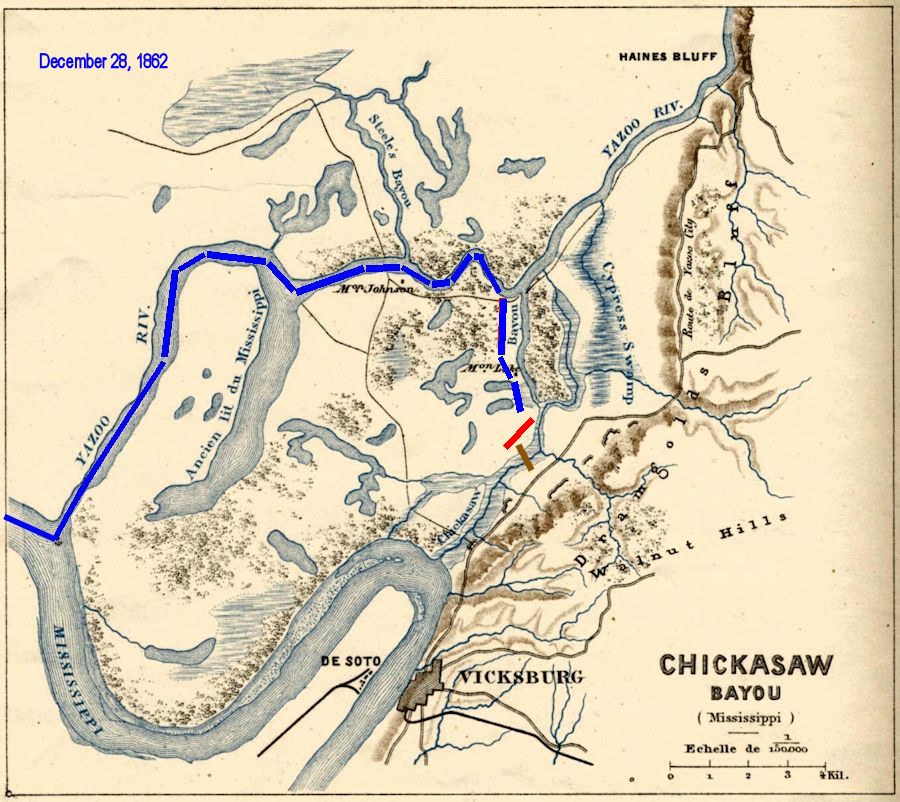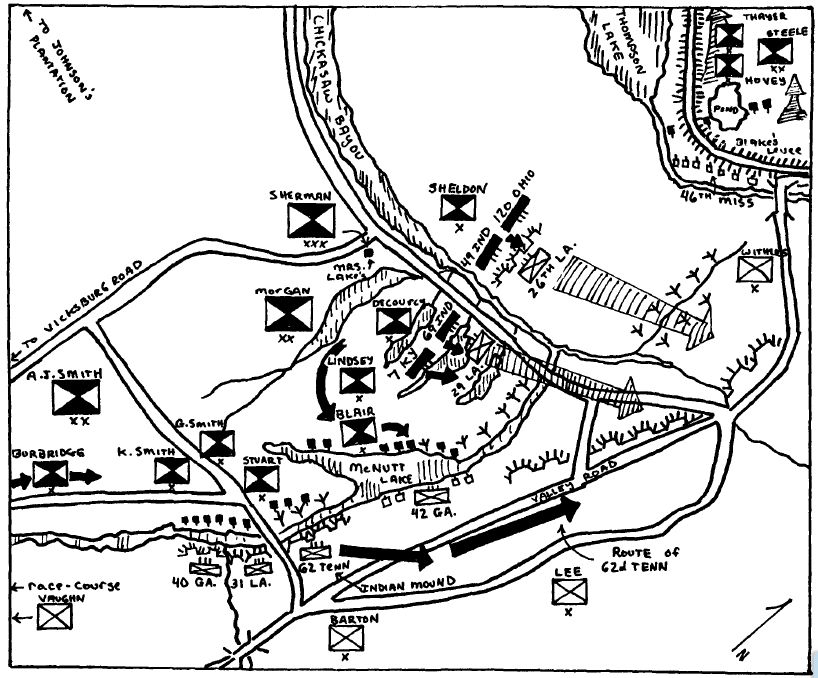| Previous Date | Day By Day Index | 16th OVI Home Page | Next Date |
Where was the regiment on
Sunday, December 28, 1862
On this day at 8:00am the soldiers of the 16th Ohio were awakened by cannon fire on their right, apparently made by Gen. A. J. Smith, commanding Sherman's First Division. The 16th soldiers were soon in formation and moved to the front. Reports indicate the 16th marched about 1/2 mile and formed a line supporting the 7th Michigan Battery and soon after opened fire on Confederate troops who were posted in a strip of woods about 800 yards in front. In his diary, Pvt. Peter Perrine states:
The enemy's bullets hardly reached us yet by appearances ours effected them severely. An incessant fire was kept up all forenoon. Regiments relieving each other by turns. In the afternoon we charged into the woods driving the enemy into their stronghold on the bluffs. The roar of artillery and musketry was terrific, lasting until dark. We lay on the field tonight.
Cpl. Theodore Wolbach, Company E, remembers:
On the morning of the 28th, when it was sufficiently light to discern objects a few rods distant, the opposing pickets opened fire at each other, and some entrenched artillery of ours in advance of our regiment, put in a shot once in a while. Mounted orderlies and staff officers dashed briskly about carrying orders, and presently the 16th was called to 'attention,' and marched by the flank, four abreast, out past the advance pickets who were lying flat on the ground or crouched behind such obstacles as would protect the body. Strange as it may seem, all firing ceased when we made our appearance on the dangerous ground. The pulse of the timid beat quicker, but the 16th moved solidly and resolutely, and strictly obeyed their commanding officer, Lieut. Col. Phillip Kershner, who was mounted and rode at the head of the column. When we had well cleared our picket's front, we filed to the right, and formed line in gigantic burrweed that was very annoying as the dry, hard burrs came loose from the stalk at the touch and stuck tenaciously to our woolen clothing. Less than a hundred yards from our line, in front, was a forest of heavy timber. The wide-spreading branches were festooned with moss. The foe, in numbers unknown to us, were crouching beneath the canopy. Why they did not fire at us was a mystery, but we were not destined to wait long. Soon the order was given to commence firing from the right of sections. The boys obeyed deliberately and with coolness. As soon as we commenced the rebels replied with vigor. A part of Lamphere's 7th Michigan Battery galloped into position on our left and took a 'hand in the action.' The rapid firing soon produced a thick smoke, that, while it lingered around us, rendered objects indistinct a short distance off. The cannoneers, first distinctly outlined, soon looked like spectres in the sulphurous fog. The thumping sound of the field pieces, as they sent their iron bolts into the forest, with the rattling musketry fire, soon produced that partial deafness that all soldiers experience that pass through the ordeal of noisy battle. Other troops came up and joined in , and as the air became lighter, the smoke ascended revealing the pugnacious 'Yankee invader' at his spiteful, deadly work. A part of the 16th was relieved by another regiment. Retiring a short distance they were ordered to lie down. Several here were struck by the enemy's balls, but none seriously hurt. Lieutenant Boling, of Company B, got a rap on the breast that made him feel sick and might have been worse but for his leather shoulder belt that cushioned the bullet. Beu Pursell, of the same Company, was struck on the arm by a spent ball. In the shifting of the position of the troops, a small part of our regiment was thrown forward as skirmishers, and the balance of the companies, formed in column of divisions, acted as a support.
A very intelligent and well educated Frenchman named Girard, who had recently enlisted in one of the Holmes Co. companies, unexpectedly furnished a little fun for his comrades here in the woods, while we were skirmishing in the advance. Every man applied his own tactics and used his own judgment in the fight after we were halted. Anything that would catch a bullet was sought out for shelter. In some instances a considerable number were grouped behind a common obstacle. In one of these clusters Girard was busily at work. Some fellow near him in jerking the ramrod out of his gun thumped him sharply in the ribs. Girard imagined that he was shot and with a groan rolled over helpless exclaiming seriously, 'My God! I am shot,' but almost in the same instant discovered the reality of his case and took a laugh with the boys.
George Glick, of Co. A, had the upper part of his nose between the eyes carried away by a musket ball; a half inch closer would have taken the eyes.
From the mouldering treasures of memory the survivors of that affray in the Chickasaw forest, can recall many startling experiences and miraculous escapes from death and mutilation.
When night had came and darkness had settled over us, many of those that were not in the extreme front lay down and slept, paying no heed to the frequent shots that were sent from one side or the other. Clusters of the boys, grouped together and in low tones, discussed the probabilities of the morrow.
They were moving back and forth all night. Some fellows that might have slept, if they so desired, made no effort to. The events of the day impressed on the mind and conscious that in the gloomy shadows of those old trees were the blood marks where comrades had fell dead or disabled, kept the nerves of the thoughtful in a poor condition for slumber. Down along the bayou, in the dark forest, far to our right, where other divisions of our corps were deployed, a shot now and then told us that the soldier on the skirmish line was vigilant there too. So the night, damp and chilly, slowly passed, and the foggy dawn made its appearance.
* Information and italicized quotations from a series of articles entitled Camp and Field - The Old 16th Ohio, written in the 1880s by Theodore Wolbach, late Corporal in Company E, 16th Ohio Volunteer Infantry.
An anonymous author of a letter to the Tuscarawas Advocate newspaper tells his story of December 28, 1862:
On Sunday the 28th our men formed in line in front of the rebels and after a hard fight through the woods and over bayous, succeeded in driving them behind their earthworks on the hill side. Gen. Morgan's Division did the principal fighting, and sustained the heaviest loss. All that night the men lay on their arms within a few hundred yards of the enemy, while our Surgeons were busy sawing off arms and legs, and binding up wounds till the gray dawn. That was my first sight of blood.
Read the complete letter.
Period map showing the approximate movement of DeCourcey's brigade, south, along Chickasaw Bayou and toward Chickasaw Bluffs or Walnut Hills. The red line indicates location of a battery of Rebel field artillery and troops on the north side of the bayou (McNutt Lake or Fishing Lake). Chickasaw Bayou, which runs south from the Yazoo River, turns to the east at the junction with McNutt Lake:

A more detailed map showing the locations of Union and Confederate forces on December 28, 1862.
map drawn by Major Gray M. Gildner, U. S. Army, 1991

| Previous Date | Day By Day Index | 16th OVI Home Page | Next Date |